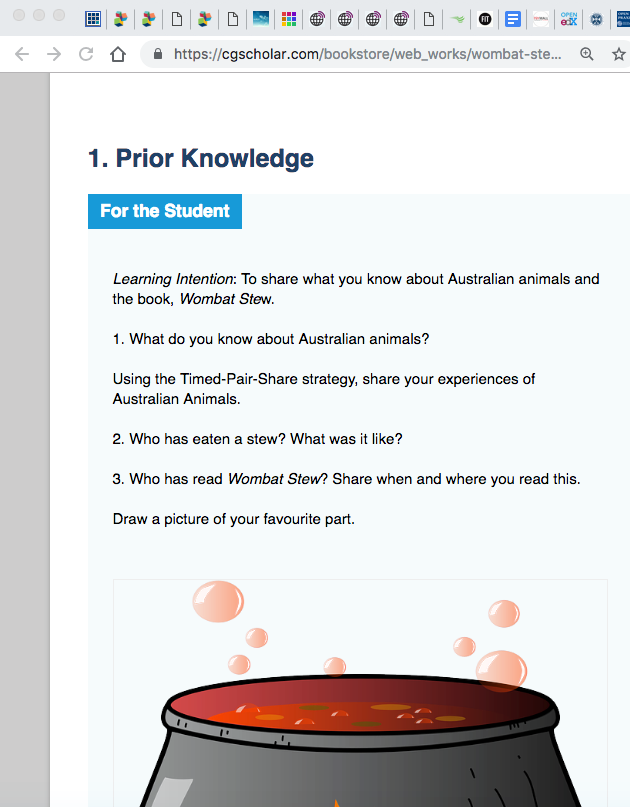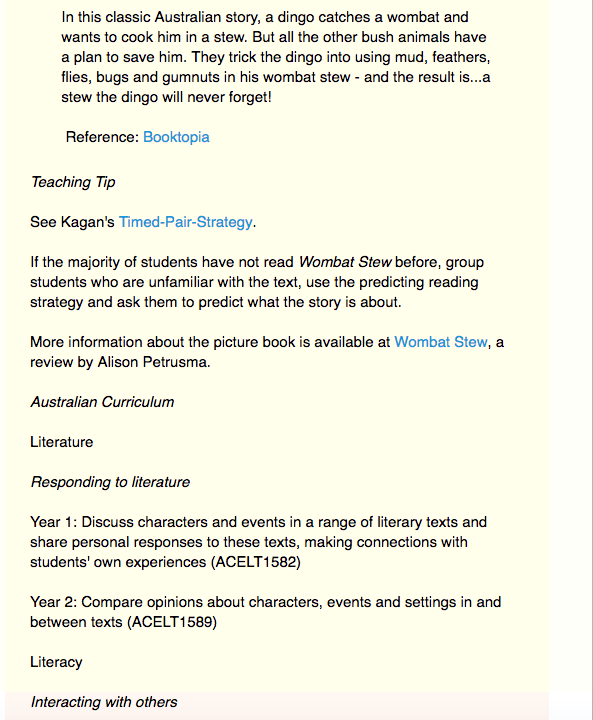Multimodal Literacies MOOC’s Updates
Lessons on Reading in a Non-Native Language
Here, I am not talking about teaching literacy at a basic level. Rather, the focus is on my experience helping students improve their reading skills in a non-native language, in this case, French. What I find surprising, though, is that a lot of the same approaches that we have seen in basic literacy education applies here. Indeed, some of the exercises and activities from the materials to help Year 1-2 students read Wombat Stew are similar to aspects of my approach to teaching college students to read, comprehend and express informed opinions about literary texts in French.
https://cgscholar.com/bookstore/web_works/wombat-stew?category_id=learning-by-design-modules-k12
If we look, for example, at the pre-reading exercises for Wombat Stew, we'll see some strategies that link to ones that I use in my own reading:
In this example, before reading the text, learners are asked to draw on their previous knowledge of some of the content, to recall concrete examples of experiences that they have had, including learners who have read the text before. Learners share with each other to construct an ensemble of information that will help contextualize the reading and make it meaningful. The teacher gets addition suggestions and guidance for helping engage learners in the reading and meaning-making process:
As we see in the preceding, the second screenshot, teachers ask learners who have never read the text to predict what is going to happen. This engages the readers and invites them to follow the story carefully to see whether or not it matches their predictions. The teacher also guides students in their reactions to the text, focusing on characters and events. Again, there is a focus on sharing, on collective meaning-making and on engagement. These strategies use a variety of modalities and foci to help learners construct a cogent understanding of the text and to figure how to decode and contextualize the text by focusing plotlines, on ideas and on relationships between characters. That way of focusing reading provides a broad-based way of extending reading skills and intepreting the meaning of written language. In a word, this is not an alphabetical or phonemic approach. Rather, it concentrates on larger meanings, with the assumption that learners will, in time, using contextualized language, figure the associated sounds and functional relationships of letters as components of words and words as components of sentences. In this teaching approach, which employs collaboration and exchange as part of the reading process, more advanced learners can help less advanced ones understand the gist of texts and begin to guess the letter-to-sound and sound-to-meaning relationships of particular words, based on broad narrative-textual meanings and contextualization.
In my own "introduction to literature" classes, I used many of the same strategies with college students who had some understanding of the target language and who could, with considerable skill, phonemically decode words and meanings, but who were not necessarily well-prepared to understand everything at the morphemic level and who were not at all familiar with symbolic and formulaic meaning-making in French-language literary texts. That is, they had some level of phonemic understanding and a lower level of morphemic understanding, but none whatsoever of literary or cultural conventions. So what I tried to do was to get them to draw on their own experience, which I asked them to share, to construct soms contexts for our literary readings, to make predictions about how the text would unfold, to speculate about higher meanings.
Sharing and discussion was a major part of classroom activity in my courses. I asked students to decode and comment on narrative events and relationships between characters, to pick out unusual utterances or language structures, to investigate them, and to share with their classmates what they found. I asked them to map some of the formulae and stylistic particularities onto their own reading experience in English. Over time, students were able to see, then, that "Il était une fois..." at the beginning of certain stories was the functional equivalent of "Once upon a time..." in the English-language tradition. Over time, they connected their experiences, including reading experiences in both English and French, with what they already knew of the world and with the reading experiences and world knowledge of their classmates. Over time, they built up a wealth of information that helped them contextualize and interpret literary texts in the French tradition. In the process, they slowly expanded their horizons and learned some of the literary conventions of the French-speaking world. I also gave students other ways of conceptualizing the qualities of literary texts, in the form of word lists formed on notion of tension or opposition, diagrams of plotlines, drawings evoking relationships between characters, graphic representations of textual components, and so forth. I also asked them to write their own fairy tale in French.
By actively engaging students in broad-based and connected/contextualized meaning-making, enacted through collaborative work and sharing, I was using many of the same strategies as those present in the Wombat Stew lesson plans referred to in chapter 9 of Literacies and in the corresponding module of the Coursera course, "Multimodal Literacies: Communication and Learning in the Era of Digital Media."
My example is not a perfect analogy, but there are enough overlaps and correspondences to suggest that the different instructional processes are built on similar pedagogies and similar understandings of literacy and learning.



